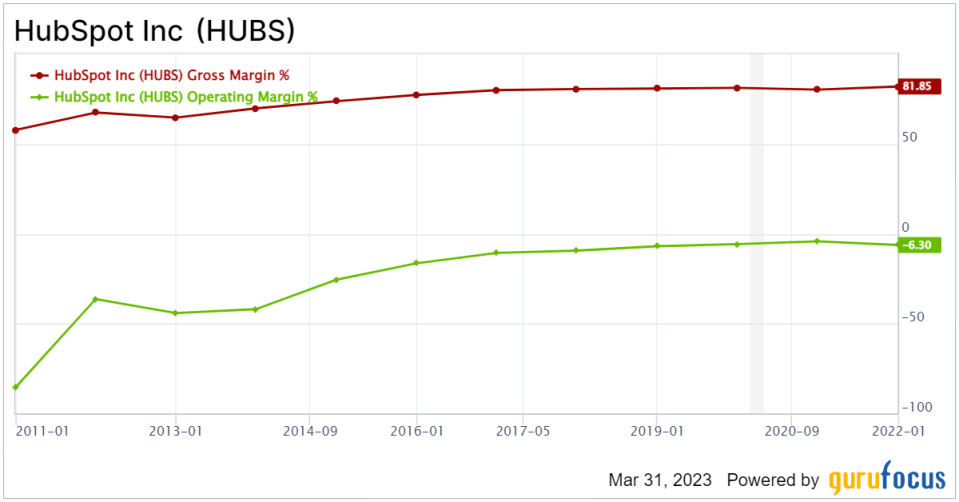HubSpot (NYSE:HUBS) is a leading software company that offers a suite of products for inbound marketing, sales and customer service. Founded in 2006 by Brian Halligan and Dharmesh Shah, the company’s primary product is the HubSpot Growth Platform, an all-in-one solution that combines these distinct channels and more. The company uses “freemium” tactics to drive customer growth, which was 24% year over year in 2022. HubSpot now has over 167,000 customers, with 8,400 customers added in the fourth quarter.
Business model breakdown
HubSpot’s product offerings can be broken down as follows:
-
Marketing Hub: This includes tools for content management, search engine optimization (SEO), email marketing, social media marketing, analytics and more. It helps businesses create and promote engaging content to attract leads and convert them into customers.
-
Sales Hub: This offers tools for managing contacts, tracking deals, automating sales processes and forecasting revenue. It helps sales teams close deals faster and more efficiently.
-
Service Hub: This provides tools for managing customer support, tracking and resolving issues and building customer loyalty. It helps businesses provide exceptional customer service, turning satisfied customers into advocates for the brand.
-
CMS Hub: This is a content management system that allows businesses to create and manage their websites easily. It offers a range of customizable templates, responsive design and built-in SEO tools.
-
Operations Hub: This tool helps businesses synchronize, clean and maintain their data across different systems, ensuring that all teams are working with accurate and up-to-date information.
It operates a Cloud software business model, which is among the best business models for profitability. It is generally able to automate much of the customer touchpoints and onboarding to scale. Costs are relatively fixed and the margins are incredible.
Many companies choose to sacrifice short-term profits by maximizing sales and marketing spend. It’s a luxury that subscription models can afford better than other models, considering the premium investors are willing to pay for revenue growth and the promise of future profits.
The crucial aspect of HubSpot’s strategy is targeting the small- and medium-sized business (SMB) segment, where it can customize offerings to cater to businesses of specific sizes. By providing free tiers and scalable pricing options based on feature requirements, HubSpot ensures a smooth onboarding experience and a comprehensive suite of tools that serve as a nearly all-in-one solution.
HubSpot has become the go-to option for many SMBs, which have often been overlooked by cloud software providers. The company’s ability to consistently develop and deliver high-quality additional features enables a land-and-expand approach, which serves as a key competitive advantage for HubSpot. 98% of HubSpot’s revenue comes from subscription services, which are very sticky. Companies are pushing more on soft marketing and utilizing social media to attract customers, rather than relying on direct sales. As a result, HubSpot’s share of the overall CRM market could continue to expand.
Financials
For a company that has been around since 2006, it should be profitable at this point. Yet, despite enjoying gross margins of 82%, HubSpot has decided to spend a large chunk of its profits on research and development. In 2013, the company had $15 million in R&D expenses on $50 million in gross profit. Not much seems to have actually changed in the product since then, but the R&D expense has risen to $422 million. This expense puts the company considerably in the red, taking up nearly 30% of its operating expenses. By comparison, industry leader Salesforce (NYSE:CRM) only spends 21% on R&D.
Some metrics are not so great for a technology company. HubSpot, like many of these SaaS operations, needs a lot of people to function properly. It has over 7,000 employees and generates around $235,000 in revenue per employee. In comparison, Salesforce gets over $390,000 in sales per employee.
The company also needs to address the issues surrounding stock-based compensation dragging down profitability as well. I think it spends way too much to compensate its top executives considering the company’s continued lack of profitability.
That being said, 2023 is all about artificial intelligence, and OpenAI’s GPT platform may allow HubSpot to drive more revenue per employee. I hope the company decides to tap into AI as a source of growth, as I believe this could help a lot. Only time will tell whether or not the company can utilize it well.
Valuation
Historically, it has been a bad idea to bet against the technology industry as a whole. However, that alone does not make HubSpot worth owning, as the tech industry has more duds than winners.
HubSpot is currently experiencing a rather dramatic slowdown. The company anticipates $2.05 billion to $2.06 billion in revenue for 2023, which equates to nearly 19% year over year growth. This comes after 33% growth during 2022 and 47% revenue growth in 2021. At this rate, it would take another 16 years to reach the level Salesforce is at today.
Of course, the stock’s current multiples are based on an incredible growth rate achieved in the last five years, which is slowing considerably. Thus, I think it is likely only a matter of time before the market re-adjusts HubSpot’s value lower.
This article first appeared on GuruFocus.











